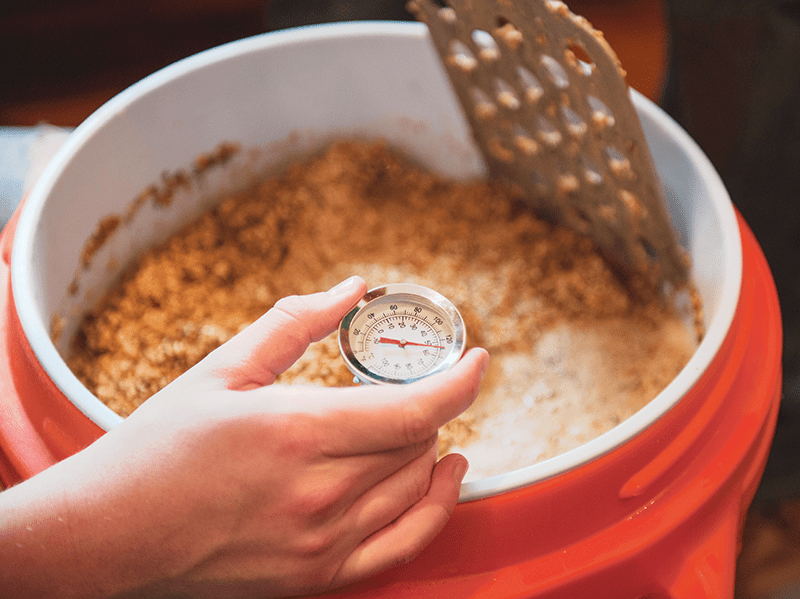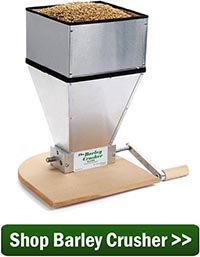 As many of you know, using the infusion mashing process is just one of the ways that grains can be used to make wort (which is then turned into beer by yeast). In this article, we will go over the basics of the infusion mashing process, followed by step-by-step instructions for a single infusion mash.
As many of you know, using the infusion mashing process is just one of the ways that grains can be used to make wort (which is then turned into beer by yeast). In this article, we will go over the basics of the infusion mashing process, followed by step-by-step instructions for a single infusion mash.
The Science of Infusion Mashing
For the starches in malted grain to be converted into fermentable sugar, they must be mixed with water and held under certain conditions. This process is called saccharification.
Four main variables affect how much of the available starches are converted during the infusion mashing process: time, pH, temperature, and mash thickness. The ideal values for each of these variables are as follows*:
Time: 30-60 minutes
pH (acidity): 5.4
Temperature: 149°F. (65C)
Thickness: 1.5 qts. water/lb. grain
In theory, it should only take about 30 minutes for saccharification to complete, but many brewers employ a 60-minute mash just to be safe. Conversion will take place at a pH between about 5 and 7, but 5.4 is the ideal target. Finally, conversion will happen at temperatures ranging from about 148°F. to 158°F., but if there isn’t enough heat the starches won’t convert. If there’s too much heat, the enzymes that are responsible for conversion will become less active and possibly denatured.
Further, brewers can raise or lower mash temperatures within a given range to control the amount of fermentable sugars in the wort. A mash around 148°-150°F. will create a more fermentable wort and result in a drier beer. A mash around 154°-158°F. will create a less fermentable wort. This will result in a higher proportion of unfermentable sugars in the wort, meaning a sweeter beer with a heavier mouthfeel and body.
Single vs. Step Infusion Mashing
Grains that have been “well-modified” (i.e. malted to maximize their conversion potential) usually just require a one step mash, which we call a single infusion mash. Grains that are less modified may require additional processing in the mash tun.
If brewing with a high proportion of less modified malt, the brewer may choose to add an additional step in the infusion mashing process. Before the saccharification step, they may want to do a “protein rest”. This simply means mashing the grains at a lower temperature (~122°F.) to help proteins break down and makes starches more accessible, then raising the mash temperature for the saccharification rest (~149°F.). Because modern malting practice has made most malt well modified, a single step infusion mash is usually sufficient.
Instructions for the Single Infusion Mashing Process
- Crush malted grains.

- Fill mash tun with 1.5 qts. of clean water at 165°F. for every pound of grain.
- Mix crushed grains with the water and stir.
- Hold mash temperature between 148°F. and 158°F. If too low, add hot water, if too high, add cold water.
- Check pH using a digital pH meter or pH test strips.
- If above 5.5 add ¼ teaspoon of gypsum and stir. If below 5.0, add ¼ teaspoon of calcium carbonate and stir.
- Hold mash for 60 minutes.
- Raise temperature to 170°F. and slowly begin to draw off wort into brew kettle. If needed, recirculate wort through the mash until it comes out clear.
When it comes down to it, the single infusion mashing process is very simple. It’s something that anyone can do if they have a mind to. Are you ready to give it a try?
—–
David Ackley is a beer writer, brewer, and self-described “craft beer crusader.” He holds a General Certificate in Brewing from the Institute of Brewing and Distilling and is founder and editor of the Local Beer Blog.
*Source: Institute of Brewing and Distilling

Once the wort is in the brew kettle do you need to add sugar
John, with most mashes all the sugars are coming from the grains, themselves. No sugar needs to be added. In some rare instances an all-grain recipe will call for a sugar of some sort to be added during the boil, such is the case with some Belgian beer recipes, but this is not the norm.